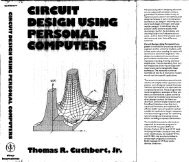Oil Circuit Breaker Explosion
Oil Circuit Breaker Explosion
Oil Circuit Breaker Explosion
Create successful ePaper yourself
Turn your PDF publications into a flip-book with our unique Google optimized e-Paper software.
Before<br />
After<br />
<strong>Oil</strong> <strong>Circuit</strong> <strong>Breaker</strong> <strong>Explosion</strong><br />
The incident occurred in a South African Coal Mine<br />
September 2009
Incident Description<br />
Description of Incident<br />
The authorised electrician undertook remote switching of an 11kV <strong>Oil</strong> <strong>Circuit</strong> <strong>Breaker</strong><br />
(OCB) at the main substation. The OCB exploded, probably due to mechanical<br />
failure, and the resultant blast wave blew off the doors of the substation, and<br />
seriously damaged the building. The electrician broke his upper right arm when the<br />
door behind which he was standing was forced violently open. An intense fire<br />
followed, destroying all equipment within the substation.<br />
Energy Coal, HSEC, September 2009
Diagram of substation layout<br />
Outgoing cable to river pump<br />
mini-substation. It was this line<br />
that had a fault that caused the<br />
Main incomer<br />
initial trip.<br />
Outgoing cables to plant, etc.<br />
Position of second<br />
electrician<br />
X<br />
Position of authorised<br />
Electrician when<br />
switching<br />
X<br />
OCB<br />
Front doors blown<br />
off, and went<br />
through a chainlink<br />
fence, finally<br />
landed 20m away.<br />
Energy Coal, HSEC, September 2009
Incident Overview (photos)<br />
This door was latched, top and<br />
bottom, and exploded outwards<br />
Position of electrician when switching. Note the flash-suit worn during operation.<br />
Energy Coal, HSEC, September 2009
Incident Overview (photos)<br />
Relays<br />
housed in<br />
this unit<br />
<strong>Breaker</strong>s in<br />
this unit,<br />
submerged<br />
in oil. Note<br />
blast<br />
damage to<br />
steel<br />
casing.<br />
Bank of OCB’s. The unit second from right exploded. The rest<br />
were damaged by the blast and ensuing fire.<br />
Energy Coal, HSEC, September 2009
Incident Overview (photos)<br />
Energy Coal, HSEC, September 2009<br />
Above: Position of front doors. They were blown towards the<br />
camera position, and though a chain-link fence, the remains<br />
of which can be seen in the foreground.<br />
Left: Doors behind which electrician sheltered during<br />
switching. Note the cracks in the brickwork. Supports were<br />
installed after the event.
Underlying Root Cause & Key Contributing<br />
Factors<br />
Underlying Root Cause:<br />
The contacts in the switchgear did not engage or disengage correctly in time to<br />
prevent prolonged arcing and subsequent oil vaporisation, which led to a violent<br />
explosion within the substation.<br />
Key Contributing Factors:<br />
1. Age of the switching equipment (OCB switchgear)<br />
2. Cable fault and the electromechanical relay not flagging the cause of the trip<br />
prior to the incident occurring<br />
3. Risk assessment not considering the explosion potential<br />
Key Learnings:<br />
1. Following procedures to the letter can save lives - operational discipline<br />
2. OCB switchgear has explosion potential and must be managed accordingly<br />
3. The fundamental success of safety depends on thorough risk assessments<br />
Energy Coal, HSEC, September 2009
Permanent Corrective Actions to be Taken<br />
Action<br />
By when<br />
Replace all OCB's with modern technology (SF6 or vacuum) 31 August 2011<br />
Ensure electrical remote switching is fitted to all medium voltage switchgear to<br />
allow for switching from outside the building (at a safe distance) in which the<br />
switchgear is housed<br />
16 October 2009<br />
Where OCB's are currently used, all baseline risk assessments must be<br />
reviewed to include mitigation strategies for explosions. The hierarchy of controls<br />
must be applied. Revise procedures accordingly<br />
30 September 2009<br />
Comprehensive testing must be done on all medium voltage switchgear. This<br />
includes oil testing, speed tests and testing of all mechanisms.<br />
31 December 2009<br />
Full flash suits must be worn when local racking and spring charging takes place<br />
on medium voltage switchgear<br />
30 September 2009<br />
Energy Coal, HSEC, September 2009

















